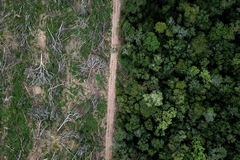Scientists identify microbes vital to making traditional mozzarella
16 Aug 2023 ---DNA analysis has led scientists to find that the mozzarella cheese making process is dominated by Streptococcus and Lactobacillus species. The research aimed to understand the dynamics of the microbial pool involved in various cheesemaking steps by comparing data from two dairies.
The team of researchers at Department of Food and Drug, University of Parma, Italy performed 16S rRNA amplicon gene sequencing on 19 intermediate samples of Mozzarella di Bufala Campana (MBC) production to evaluate their bacterial composition.
Buffalo mozzarella from Campania is a “unique Italian cheese” recognized as a delicacy and protected under EU law for nearly 30 years. It is made using basic ingredients such as water buffalo milk, rennet and natural whey starter, processed using fresh water and brine.

The natural whey starter contains microbes that are “crucial” to developing the mozzarella.
 The research aimed to understand the dynamics of the microbial pool involved in various cheesemaking steps.“This study sheds light on the intricate interactions of microorganisms throughout the manufacturing process and fosters a deeper understanding of the craftsmanship behind this esteemed Italian cheese,” says Dr. Alessia Levante of the University of Parma, lead author of the study in Frontiers in Microbiology.
The research aimed to understand the dynamics of the microbial pool involved in various cheesemaking steps.“This study sheds light on the intricate interactions of microorganisms throughout the manufacturing process and fosters a deeper understanding of the craftsmanship behind this esteemed Italian cheese,” says Dr. Alessia Levante of the University of Parma, lead author of the study in Frontiers in Microbiology.
The road to “cheesy delight”
To qualify for Protected Designation of Origin (PDO) status, buffalo mozzarella must be made according to a specific recipe. Raw or pasteurized water buffalo milk is heated and inoculated with “rennet and natural whey starter.” This starter causes the curd to acidify quickly, bringing it to the correct pH and making it stretchy enough to be molded.
The curds that form are ripened for about “four hours” until they reach the correct pH. They then become elastic and can be stretched and molded under boiling water. Further, these curds are “hardened” under running water and brined.
Levante and her team selected two dairies in Campania that produce mozzarella, which qualifies for PDO status: one larger and using more modern technology, one smaller and using more traditional processes.
They took samples of the dairies’ milk, natural whey starter, cheese curd before stretching, brine and mozzarella. This was done to “analyze the role of bacteria” and see if it changes with the type of technology used.
“While both dairies produced PDO Mozzarella di Bufala Campana (MBC), subtle variations, such as temperature and duration of processes, influenced the cheese’s microbial composition and potentially impacted organoleptic properties,” says Levante.
The findings
The team found that the pasteurized milk used by the more modern dairy added “fewer microbes” and species of microbes to the process than the “thermized milk” used by the more traditional dairy.
However, the brine samples were as rich in species as the processed cheese samples. During the curd process, a small number of species develop and take over.
The natural whey starter from the more traditional dairy had a “roughly equal” abundance of both, while the more modern dairy used a “natural” whey starter dominated by Streptococcus.  The curds that form are ripened for about “four hours” until they reach the correct pH.
The curds that form are ripened for about “four hours” until they reach the correct pH.
Some species within each genus were specific to each dairy.
After curdling, Lactobacillus “increased” and Streptococcus “dropped” in both sets of samples, possibly due to the removal of thermal stress caused by stretching.
Moreover, the species richness of samples from the dairy in which milk has been pasteurized was “lower” than that observed for the other, while similar trends were observed for the other indices.
Microbial diversity
The brine offers a source of “microbial diversity” by inoculating the external layer of the cheese with new microbes as it touches the cheese surface.
Despite the large number of species of microbes available in the milk and the brine, the study pointed out that the natural whey starter most influences the “microbial makeup” of mozzarella.
“We are planning a larger project to investigate more deeply the role of raw buffalo’s milk in defining the microbiota,” says Levante.
“This study’s scope was limited to two dairies and a specific sampling size. To provide more comprehensive insights into the microbial intricacies of traditional food production, future research aims to encompass a larger number of producers and manufacturing days,” she concludes.
Meanwhile, plant-based cheese continues to pique the interest of researchers worldwide.
By Insha Naureen













